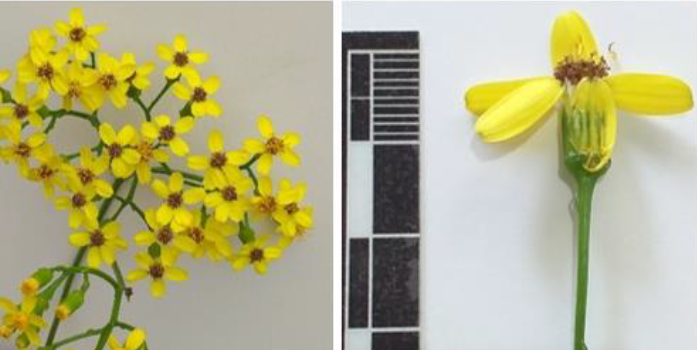Senecio angulatus L.f. (Asteraceae) a new addition to the Moroccan alien flora
DOI:
https://doi.org/10.24310/abm.49.2024.19692Palabras clave:
flora exótica, corología, nueva cita, MarruecosResumen
Senecio angulatus L.f. (Asteraceae), native to South Africa, is reported here as a new non-native plant to the vascular flora of Morocco for the first time. The species’ diagnostic morphological characters, photographic illustration, data on geographic distribution and ecology, and probable invasion pathway are provided and commented.
Descargas
Métricas
Citas
Alavi, S. (1983). Asteraceae. In S. M. H. Jafri & A. El Gadi (Eds.), The Flora of Libya vol.107. University of Tripoli, Faculty of Science, Department of Botany, Tripoli, Libya.
Angiosperm Phylogeny Group (APG-IV) (2016). An update of the Angiosperm Phylogeny Group classification for the orders and families of flowering plants: APG IV. Botanical journal of the Linnean Society, 181(1), 1-20.
APD African Plant Database (version 3.4.0) (2024). Senecio angulatus L. f. in North Africa. https://africanplantdatabase.ch/en/nomen/specie/97995/senecio-angulatus-l-f. Accessed on 2024-02-12.
Bacchetta, G. & García-Berlanga, O. M. (2009). Catálogo de la flora exótica de la isla de Cerdeña (Italia). Flora Montiberica, (41), 35-61.
Baker, M. & Duretto, M. (2013). A census of the vascular plants of Tasmania. Tasmanian Herbarium, Tasmanian Museum and Art Gallery Department of Economic Development, Tourism and the Arts: Hobart, 1-144.
Barina, Z., Pifkó, D. & Mesterházy, A. (2011). Contributions to the flora of Albania, 3. Willdenowia, 41(2), 329-339. doi: 10.3372/wi.41.41214
Bergin, D. (2006). Options for restoration of Cape ivy (Senecio angulatus)-dominated sites using native coastal species, Glinks Gully, Northland. Ensis, New Zealand, 12.
Boudik, S., Khamar, H., Magri, N., Belahbib, N., Zidane, L., Benkhnigue, O. & Dahmani, J. (2024). Study of the Floristic Diversity of the Moulay Driss Zerhoun Region in the Prerif Range, Morocco. Egyptian Journal of Botany, 64(1), 27-63. doi: 10.21608/ejbo.2023.176949.2202
Brunel, S. & Tison, J. (2005). A method of selection and hierarchization of the invasive and potentially invasive plants in continental Mediterranean France. Invasive Plants in Mediterranean Type Regions of the World, 34-43.
Buján, M. I. R. (2007). Flora exótica de Galicia (noroeste ibérico). Botanica Complutensis, 31, 113-125.
CABI Centre for Agriculture and Bioscience International (2023). Senecio angulatus. https://www.cabidigitallibrary.org/doi/full/10.1079/cabicompendium.117058. Accessed on 2023-10-02.
Castro, S. & Muñoz-Schick, M. (2006). Compuestas naturalizadas en Chile : Importancia de la flora exótica como agente del cambio biótico. Revista del Jardín Botánico Chagual, 4, 29-35.
Cottaz, C., Krebs, E., Aboucaya, A. & Corbobesse, Y. (2017). Expérimentation d’éradication du Séneçon anguleux Senecio angulatus au sein du Parc national de Port-Cros—Mise en oeuvre de l’observatoire transfrontalier Franco-Italien des espèces végétales exotiques envahissantes dans le cadre du programme Interreg Marittimo ALIEM. (Rapport du Conservatoire botanique national méditerranéen de Porquerolles et du Parc national de Port-Cros).
Delucchi, G., Bayón, N. D. & Hurrell, J. A. (2016). Senecio angulatus (Asteraceae, Senecioneae) naturalizada en la Argentina. Boletín de la Sociedad Argentina de Botánica, 51(1), 169-177.
Dobignard, A. & Chatelain, C. (2011). Index synonymique de la flore d’Afrique du Nord. Dicotyledoneae : Acanthaceae-Asteraceae, 2. Genève: Conservatoire et Jardin botaniques de la Ville de Genève, ECWP.
Eftekharian, R., Sheidai, M., Attar, F., Noormohammadi, Z., & Ghasemzadeh-Baraki, S. (2018). Molecular and morphological study of the genus Senecio L.(Asteraceae : Senecioneae) in Iran. Genetika, 50(2), 403-419. doi: https://doi.org/10.2298/GENSR1802403E
Fennane, M., Ibn Tattou, M. & El Oualidi, J. (2014). Flore pratique du Maroc. Volume 3. Travaux Institut Scientifique, Rabat, Maroc, 40, 1-653.
Fennane, M. & Ibn Tattou, M. (2008). Statistiques et commentaires sur l’inventaire actuel de la flore vasculaire du Maroc. Bulletin de l’Institut Scientifique, Rabat, 34(1), 1-9.
Fennane, M. & Ibn Tattou, M. (1998). Catalogue des plantes vasculaires rares, menacées ou endémiques du Maroc. Bocconea, 8, 5-243.
Foden, W. & Potter, L. (2005). Senecio angulatus L. f. - National Assessment : Red List of South African Plants. http://redlist.sanbi.org/ species.php?species=3152-25 accessed on 2023-01-11.
Galasso, G., Conti, F., Peruzzi, L., Ardenghi, N., Banfi, E., Celesti-Grapow, L. & Ballelli, S. (2018). An updated checklist of the vascular flora alien to Italy. Plant Biosystems-An International Journal Dealing with all Aspects of Plant Biology, 152(3), 556-592.
González Costales, J. A. (2007). Plantas alóctonas invasoras en el Principado de Asturias. Ministry of the Environment, Territorial Planning and Infrastructure and Social Work « La Caixa ».
Greuter, W. (2003). The Euro Med treatment of Senecioneae and the minor Compositae tribes—Generic concepts and required new names, with an addendum to Cardueae. Willdenowia, 33(2), 245-250.
Herrero-Borgoñón, J. (2002). Situación de Senecio angulatus L. fil. y Senecio mikanioides Otto ex Walpers (Asteraceae) en el Mediterráneo español. Butlletí de la Institució Catalana d’Història Natural, 70, 45-46.
Iamonico, D. (2017). Alien taxa of the tribe Senecioneae (Asteraceae) in Italy: A nomenclatural synopsis. Hacquetia, 16(2), 281-292.
Ibn Tattou, M. & Fennane, M. (2008). Flore vasculaire du Maroc : Inventaire et chorologie, Asteraceae et Monocotylédones. Travaux de l’Institut Scientifique, 1-398.
Khamar, H., Benkhnigue, O. & Zidane, L. (2021). Euphorbia hirta (Euphorbiaceae): A new naturalized xenophyte in the vascular flora of Morocco. Flora Mediterranea, 31, 199-206. doi: https://doi.org/10.7320/flmedit31.199
Khamar, H. (2022a). Lectotypification of Mentha gattefossei Maire, a plant endemic to Morocco. Phytotaxa, 554(3), 297-300. doi: https://doi.org/10.11646/phytotaxa.554.3.9
Khamar, H. (2022b). Révision taxonomique et morphologique du genre Verbascum L. au Maroc (PhD Thesis). Ibn Toufaïl University, Kénitra.
Khamar, Hamid, Benkhnigue, O., Douira, A., Zidane, L. & Touhami, A. O. (2022). Phyllanthus tenellus Roxb. (Phyllanthaceae), a newly naturalising species in Morocco. Check List, 18(2), 411-417. doi: https://doi.org/10.15560/18.2.411
Khamar, H., El Oualidi, J., Touhami, A. O. & Civeyrel, L. (2023). Nomenclature and typification in Verbascum (Scrophulariaceae) from North Africa. PhytoKeys, 225, 115-152. doi: https://doi.org/10.3897/phytokeys.225.99356
Lawrence, M. E. (1980). Senecio L. (Asteraceae) in Australia: Chromosome numbers and the occurrence of polyploidy. Australian journal of botany, 28(2), 151-165.
Lotfi, E., Yousefi, M. & Asadi, M. (2010). A revision of Senecio L. (Asteraceae, Senecioneae), in Iran. The Iranian Journal of Botany, 16(1), 96-106.
Mehelis, C. N., Balciunas, J. K., Reddy, A. M., Van Der Westhuizen, L., Neser, S. & Moran, P. J. (2015). Biology and host range of Digitivalva delaireae (Lepidoptera : Glyphipterigidae), a candidate agent for biological control of Cape-ivy (Delairea odorata) in California and Oregon. Environmental entomology, 44(2), 260-276.
Miara, M. D., Boutabia, L., Salah, T. & Véla, E. (2018). Apparition de Senecio angulatus (Asteraceae) en Algérie. Flora Mediterranea, 28, 111-118. doi: https://doi.org/10.7320/FlMedit28.111
Milović, M., Mitić, B. & Alegro, A. (2010). New neophytes in the flora of Croatia. Natura Croatica: Periodicum Musei Historiae Naturalis Croatici, 19(2), 407-431.
Newton, P. M. (1996). Effective control of creeping groundsel (Senecio angulatus). 444-445, https://caws.org.nz/old-site/awc/1996/awc199614441.pdf. Accessed on 2024-02-26.
Otto, R. & Verloove, F. (2016). New xenophytes from La Palma (Canary Islands, Spain), with emphasis on naturalized and (potentially) invasive species. Collectanea Botanica, 35, e001.
Pérez, J. J. H.-B. (2009). Notas sobre flora alóctona valenciana. Flora Montiberica, 43, 19-25.
POWO (2024). Plants of the World Online. Facilitated by the Royal Botanic Gardens, Kew. http://www.plantsoftheworldonline.org/. Accessed on 2024-01-12.
Pyšek, S. (2008). Contribution to the knowledge of Catalan foreign flora. Collectanea botánica, 27, 95-104.
Randall, R. P. (2007). The introduced flora of Australia and its weed status. CRC for Australian Weed Management Adelaide.
Stierstorfer, C. & von Gaisberg, M. (2006). Annotated checklist and distribution of the vascular plants of El Hierro, Canary Islands, Spain. Englera, 3-2.
Thiers, B. (2024). Index herbariorum : A global directory of public herbaria and associated Staff. New York Botanical Garden’s Virtual Herbarium. http://sweetgum.nybg.org/science/ih/. Accessed on 2024-02-24.
Valdés, B., Rejdali, M., Achhal El Kadmiri, A., Jury, S. L. & Montserrat, J. M. (2002). Catalogue des plantes vasculaires du Nord du Maroc, incluant des clés d’identification. Madrid : Consejo Superior de Investigaciones Científicas.
Webb, C. J., Sykes, W. R. & Garnock-Jones, P. J. (1988). Flora of New Zealand, Volume IV: Naturalised pteridophytes, gymnosperms, dicotyledons. Christchurch, N.Z: Botany Division, DSIR.

Publicado
Cómo citar
Número
Sección
Licencia
Derechos de autor 2024 Acta Botanica Malacitana

Esta obra está bajo una licencia internacional Creative Commons Atribución-NoComercial-CompartirIgual 4.0.
Toda la información relacionada con la licencia de uso de los trabajos publicados en Acta Botanica Malacitana y con los derechos de autor se pueden consultar en nuestra Política Editorial.






1.png)


